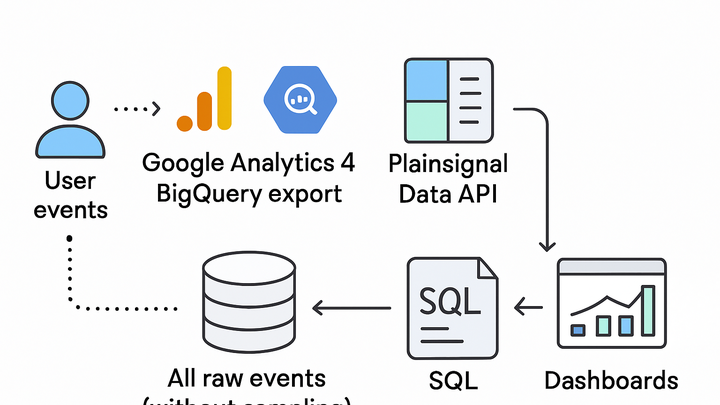Published on 2025-06-27T20:45:36Z
What is a Full Dataset in Analytics?
In analytics, a full dataset refers to the entire collection of raw events or records captured by an analytics platform, without any sampling or aggregation. It includes every data point generated by user interactions, providing maximum accuracy and flexibility for detailed analysis. Accessing a full dataset allows analysts to perform deeper segmentation, custom reporting, and precise measurement of KPIs. In platforms like Google Analytics 4 (GA4), a full dataset can be exported to BigQuery, enabling SQL queries on every event. Cookie-free analytics tools such as PlainSignal also offer full dataset access through their Data API, capturing all pageviews and custom events. Having a full dataset is crucial for advanced use cases like machine learning, anomaly detection, and multi-dimensional analysis. However, working with full datasets requires attention to data volume, cost, and query performance. This article explains why full datasets matter, how to access them in GA4 and PlainSignal, and best practices for managing and querying unsampled data.
Full dataset
A full dataset is the complete, unsampled set of raw analytics events for accurate, detailed analysis.
Why Full Datasets Matter
Full datasets provide the foundation for precise insights by including every event, avoiding biases introduced by sampling or aggregation. They are critical for advanced analytics tasks like cohort analysis, predictive modeling, and custom attribution.
-
Accuracy in reporting
With unsampled data, metrics reflect true user behavior, eliminating estimation errors common in sampled reports.
-
Flexibility for deep analysis
Full datasets allow you to slice and dice data by any dimension or event property without restrictions imposed by pre-aggregated metrics.
Accessing a Full Dataset
Different analytics platforms offer varying methods to access full datasets, from built-in exports to API endpoints.
-
Google analytics 4 bigquery export
GA4 lets you export all raw events to BigQuery for custom SQL queries across your entire dataset.
-
Example sql query
SELECT event_date, event_name, COUNT(*) AS total_events FROM `your_project.your_dataset.events_*` GROUP BY event_date, event_name ORDER BY event_date;
-
-
PlainSignal data api
PlainSignal captures all pageviews and custom events without cookies, accessible via its Data API.
-
Tracking code snippet
<link rel="preconnect" href="//eu.plainsignal.com/" crossorigin /> <script defer data-do="yourwebsitedomain.com" data-id="0GQV1xmtzQQ" data-api="//eu.plainsignal.com" src="//cdn.plainsignal.com/plainsignal-min.js"></script>
-
Best Practices for Working with Full Datasets
Handling a full dataset effectively involves strategies around storage, cost, and performance.
-
Data partitioning
Partition your data by time (e.g., date) to speed up queries and reduce costs.
-
Cost management
Monitor storage and query costs; use data retention policies and filter unnecessary events to optimize spend.
-
Query optimization
Use SELECT with explicit fields, leverage partition filters, and avoid SELECT * to improve query efficiency.
Common Challenges and Solutions
Full datasets can be powerful but present challenges around scale and compliance.
-
Data volume
Large volumes can slow down queries and inflate costs; consider aggregating older data or using materialized views.
-
Privacy compliance
Ensure your data collection practices comply with regulations like GDPR and CCPA; anonymize or exclude personal identifiers as needed.
